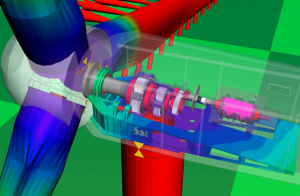Introduction
There is no doubt that we are living in increasingly precarious times, with climate change posing many new challenges and risks to life on Earth. The development and use of wind turbines and wind energy alleviates our reliance on fossil fuels, and therefore is crucial in reducing carbon emissions, minimizing harmful long-term effects of climate change on our environment. Wind energy is also cost-effective, creates jobs, and is sustainable. Simulation ensures that these important structures are running effectively and efficiently, imperative to their success as an alternative energy source.
So, how do wind turbines generate electricity? The rotor blades are key to the turbine’s operation; as wind flows across the blades, the rotor spins. The rotor connects to a generator, and as the aerodynamic force translates to the generator, electricity is created.
Wind turbines are usually grouped together in wind power plants, which are located according to factors such as wind conditions and surrounding terrain. These plants also contain a substation, to which the turbine-generated electricity runs. Within the substation, transformers convert the electricity from high voltages to lower, safe voltages. A transmission system, consisting of a transmission tower and transmission lines, then carries the electricity from the substation to consumers.
The construction of wind turbines is not without challenges. Wind turbines have huge forces exerted on them, and as their size increases the blades are subject to deformation. Noise is also a concern as regulations tighten, and wind turbines must be quiet. Simulation is necessary to address all of these concerns, especially since physical prototypes would be costly and time-consuming to test.
Simpack and Wind Turbines: A Short History
Starting in the late 1990s, German universities were using SIMULIA’s Simpack for detailed Multibody Simulation (MBS) of wind turbine drivetrains. In 2005, Simpack had its first commercial wind customer, a certification body that required customers to deliver a more in-depth analysis of their drivetrains. Since then, Simpack has been customer-driven to extend the dynamic analyses of wind turbines beyond purely mechanical models to include multi-disciplinary components, such as aerodynamics, hydrodynamics, and control.
Today, manufacturers of wind turbines (onshore and offshore, direct-drive and geared) and drivetrains around the world use Simpack to fulfill all of their MBS requirements. With the global offshore wind market predicted to grow sixfold by 2030, this industry will remain interesting and challenging for many years to come.
5th Wind and Drivetrain Conference
On April 6-7th, we were proud to host the 5th Wind and Drivetrain Conference, the only Dassault Systèmes event that focuses entirely on wind turbines and drivetrain simulation. The conference gave anyone in the industry an opportunity to learn about the latest modeling and simulation technology specifically for wind turbine engineering. We were honored to have such a great turnout of speakers and an overwhelming number of registrations.
Over two days, we had over 30 presentations from clients and SIMULIA experts with topics including engineering of wind turbines, MBS, acoustics, aerodynamics, structure optimization, generators, drivetrain, blades, materials, offshore, and manufacturing.
The agenda featured a lineup of client and academic presenters including GE Renewable Energy, Delft University, Goldwind Science Technology, elb|sim|engineering, German Aerospace Center (DLR), TNO Energy Transition, ZF Wind Power, MesH Engineering, FVA, Technical University Dresden, RWTH Aachen, Clemson University, University of Sheffield, University of Stuttgart, Technical University of Denmark, Linnaeus University, Principia, and Chongqing University.
524 attendees from 11 different GEOs and 60 different countries participated.
Did you miss this important event? You can watch all the presentations now in the SIMULIA Community and get an unparalleled insight into the many software tools within Dassault Systèmes SIMULIA that are advancing the design, development, and optimization of wind turbines and drivetrains.
Additional resources include the following available-on-demand e-seminars:
SIMULIA offers an advanced simulation product portfolio, including Abaqus, Isight, fe-safe, Tosca, Simpoe-Mold, SIMPACK, CST Studio Suite, XFlow, PowerFLOW, and more. The SIMULIA Community is the place to find the latest resources for SIMULIA software and to collaborate with other users. The key that unlocks the door of innovative thinking and knowledge building, the SIMULIA Community provides you with the tools you need to expand your knowledge, whenever and wherever.


